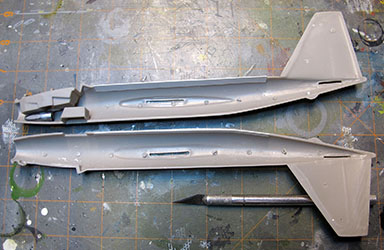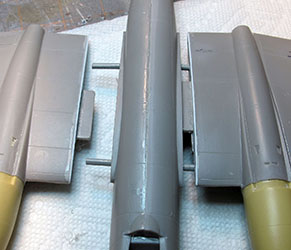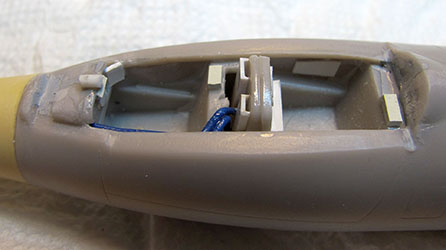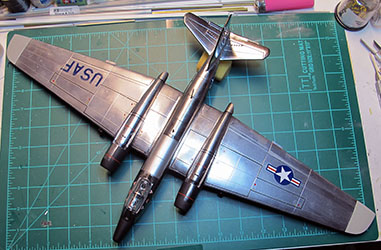
Mach 2 1/72 RB-57F Canberra Kit Build Review
By Chuck Holte
| Date of Review | February 2018 | Manufacturer | Mach 2 |
|---|---|---|---|
| Subject | RB-57F Canberra | Scale | 1/72 |
| Kit Number | 1872 | Primary Media | Styrene |
| Pros | Provides basis for unique model of important Cold War Reconnaissance aircraft | Cons | Poor instructions, fit, detail, decals |
| Skill Level | Experienced | MSRP (USD) | $95.00 |
Build Review
The RB-57F is an adaptation of the original British English Electric Canberra two-engine medium bomber. Built in the US under license, the Martin B-57 served from the late 50s into the Vietnam War as a light bomber and exceptional reconnaissance aircraft. During the Cold War, General Dynamics modified a number of the early B-57B/E aircraft, fitted with wide chord, long wings enabling them to fly at high altitudes and for long distances. These aircraft were coded as RB-57D/F model aircraft and used for high altitude imagery, signals intelligence and air sampling missions for the USAF, similar to the Lockheed U-2 missions of the period.
The aircraft I've modeled is RB-57F, 63-13293, assigned to the 9th WRW (Weather Reconnaissance Wing), McClellan AFB CA and deployed to units worldwide as needed. It was formerly B-57B, #52-1583 before rebuild by GD. Following retirement by the USAF in the early 70s, it was displayed outdoors at Warner Robins AFB GA Museum, where I photographed it in March 1994. It was recalled for flight once again several years ago. It was completely rebuilt after more than 40 years of storage and passed to NASA last year.
The General Dynamics RB-57F rebuild of the Martin B-57 version of the British Canberra has long been one of my favorite reconnaissance aircraft. The long, wide-chord wings sporting two huge TF-33 engines is quite distinctive in real life and translates easily to an eye catching visual as a 1/72 scale model on the table. I've had both the vacuform & resin DB conversion kit (for the Italeri) and the injection molded full Mach 2 kit in my stash for years and finally decided to get to work and add the model to my recce collection.
As much as DB Resin Conversions are noted for accurate precision replacement parts, Mach 2, sadly not so much for their products. Without belaboring the often poor fit and inaccuracy of the Mach 2, I decided to combine the two kits, using the best of both where I could.
I used the DB Resin main engines and the "Patricia Lynn" nose, but not the vac-form wing extensions. I used the Mach 2 J-60 engines because they were a bit more robust than the resin versions and easier to get a good glue bond with the styrene wings.
One of my main concerns in the build was the possibility of the main fuselage top seam breaking when handling the model during construction and after, so I reinforced the top and bottom fuselage joints with wide plastic strip. The 1/72 scale wingspan is 20 inches and it wants to flex, just like the real thing. Once the fuselage was together, I drilled holes for sprue spars to go thru the fuselage and extend through the wing roots. The two spars were first cemented to the fuselage wing roots and then into the wings.
I removed the kit TF-33s and nose and added the nicely molded DB resin items. The remaining construction was mostly standard for 1/72 scale. I took care to have the correct "droop" in the outer wing panels and still have ground clearance needed for the wing tips. I used SAC white metal landing gear as a direct replacement for the relatively soft M2 kit gear.
Out of the box the M2 kit has a "rough" skin surface that wouldn't work well for my intended Alclad II aluminum finish. So, out came the wet and dry 400/600 grit sandpaper for the entire unpainted aircraft.
Several hours of sanding and polishing gave a smooth finish for the Tamiya rattle-can Gloss Black lacquer undercoat.
Once dry I used several shades of Alclad II, but predominately Polished Aluminum for the look of a jet just rolled out of the final assembly hangar.
Kit decals were poor and incomplete for the aircraft I wanted (63-13293), so spares box national insignia, numbers and details were used instead. Extensive wing-walk stripes were pieced together from Xtradecal black stripe sheet. When dry and sealed tightly to the surface, decals were sealed with Future acrylic floor polish (whatever they are calling it now).
Not an easy build or conversion, it was nonetheless a very satisfying project, and a unique addition to my Cold War Reconnaissance Collection.


























